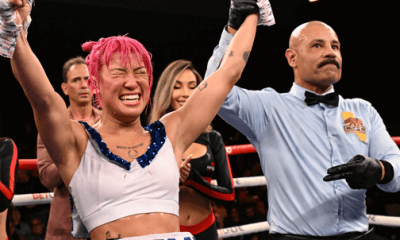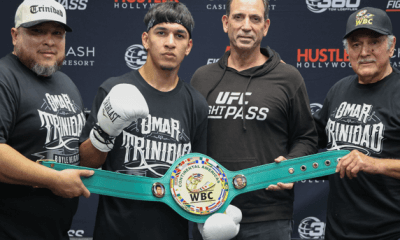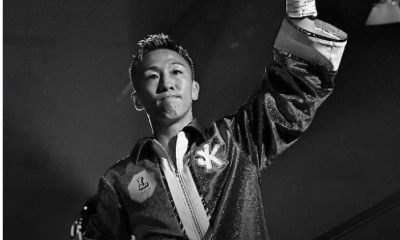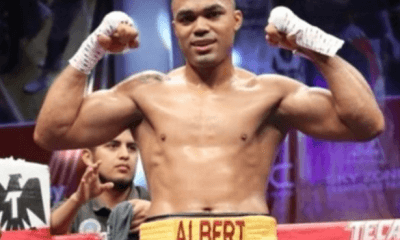Book Review
Marc Ratner Reflects on his Life in Boxing and MMA in his Newly Published Memoir
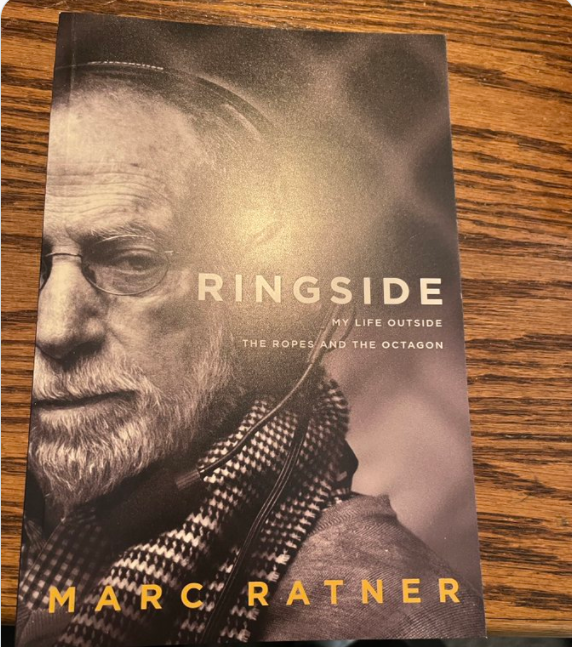
There is a nationwide shortage of high school sports officials. It’s a problem that was brewing before the pandemic drove many longtime officials to leave the fold, perhaps out of COVID concerns, perhaps because it was harder to do what they do while wearing a surgical mask. Some believe that the root of the problem lay with the parents of high school athletes; their ranks had become saturated with too many “a-holes.” And that is why last week’s meet-up with longtime friend Marc Ratner had to be pushed back. Ratner had a more important item on his agenda, a recruiting trip to the local air force base where he hoped to boat some new high school sports officials.
Ah, but I digress.
Ratner is Southern Nevada’s longest-tenured Commissioner of Officials for high school and middle school sports, a post he has held for four decades, but when one begins to list his accomplishments, one usually doesn’t start there. Among other things, the amiable Ratner, a youthful 77, is the only person to be named to the International Boxing Hall of Fame and the UFC Hall of Fame. And now he has yielded to the blandishments of his family and co-workers and set down his memories in a book. It’s called “Ringside,” sub-titled “My Life Outside the Ropes and the Octagon.”
Ratner’s career as a sports official began with Pop Warner football and city league basketball, the lowest rungs of the ladder. But out of respect to his readers – those that have never met him — his book doesn’t begin at the beginning. It opens with the 2017 fight between Floyd Mayweather Jr and Conor McGregor, an event that Ratner returns to in the final chapter. “The fight,” writes Marc, “represented a culmination of my career up to that point, the merging of my two worlds, the marriage of my past and future. Boxing was my older child who had grown up and left home, and MMA was my new child who I was still raising.”
Several days before the event, Marc was approached by Conor McGregor’s manager who had a favor to ask: Would Marc go into Floyd Mayweather’s dressing room to observe Floyd getting his hands wrapped? There are specific rules as to how much tape and how much gauze a fighter may use, and it’s standard procedure to have an inspector on hand to make sure that the rules are followed.
Marc agreed and although he wouldn’t be there in an official capacity, for him it was deju vu.
In 1987, he was named Sugar Ray Leonard’s inspector for Sugar Ray’s “Superfight” with Marvin Hagler. He delivered the gloves to Leonard’s dressing room, watched the boxer get his hands wrapped, and then hovered over Leonard’s corner between rounds to make certain that there was no hanky-panky. To this day, Marc considers that one of his most thrilling moments in sports.
Leonard-Hagler was staged at Caesars Palace on April 6, 1987. Four months later, Ratner’s best buddy Chuck Minker was appointed executive director of the Nevada State Athletic Commission, the overseer of boxing. The two had often worked in tandem at high school and junior high athletic events. They had even coached a women’s softball team. In fact, they were seen together so often that one wag dubbed them the “Gold Dust Twins.”
One of Minker’s first decisions was to elevate Ratner to his former post, that of chief inspector. Ratner never aspired to move up any higher in the hierarchy of the NSAC but in 1991 Minker was diagnosed with a rare form of lung cancer and he died the next year at age 42. Ratner succeeded him after serving as the de facto director for more than a year, a period when the position was vacant because of budgetary constraints.
Thus began Ratner’s 14-year run as the executive director of what would come to be widely regarded as the best-run boxing commission in the country. Three of the 13 chapters in Marc’s memoir focus on these days with special emphasis on the two strangest episodes of his tenure, the Fan Man Fight and the Bite Fight.
The most surreal moment in any major athletic contest happened on Nov. 6, 1993 at the outdoor arena at Caesars Palace when a paraglider identified as James Miller swooped out of the sky and crash landed in the ring during the seventh round of the world heavyweight championship fight between Riddick Bowe and Evander Holyfield, the middle match of their celebrated trilogy. From the first bell to the last, the seventh round consumed almost 24 minutes.
Marc kept his wits about him during the pandemonium, communicating with the judges and timekeeper so that the fight could be resumed as if nothing had happened. (In hindsight, he faults himself for not sending Bowe and Holyfield back to their respective dressing rooms on a night when there was a chill in the air.)
The Bite Fight on June 28, 1997 at the MGM Grand was actually the Bites Fight. Mike Tyson was a serial offender that night, returning for a second helping after taking a bite out of Evander Holyfield’s ear.
Marc was in his customary seat on the ring apron when Tyson went ballistic in round three, but like everyone in the arena other than referee Mills Lane and the combatants, it wasn’t immediately clear to him why Lane had a called a “time out.” It took a while to process.
When Lane told Ratner that he was disqualifying Tyson, Ratner replied, “Are you sure?” It was Marc’s way of slowing things down. “It was just my instincts kicking in from years of being an official,” he writes. “In all sports, it’s a big decision to eject someone.”
Team Holyfield wanted the fight to continue and when ring physician Flip Homansky deemed Evander fit to go, the fight was resumed. But Mills Lane wasn’t going to tolerate another bite and the third round would be the final round of the contest.
Ratner didn’t unilaterally overrule Lane when Lane first wanted to disqualify Tyson, but it would have seemed that way if, per chance, Tyson had gone on to win the fight. Ratner would have been raked over the coals in the press and he surmises that Bob Miller, who was then Governor of Nevada, would have had little recourse but to fire him.
In March of 2006, Ratner resigned from the commission to join the Ultimate Fighting Championship. The UFC had been around since 1993, but was hemorrhaging money when the Fertitta brothers, Lorenzo and Frank, second-generation Las Vegas casino operators, purchased the organization in 2001. At the time of their purchase, MMA, specifically the UFC alloy of it, was regulated in only one state; New Jersey. The late U.S. Senator and future Presidential Candidate John McCain had famously likened MMA to human cockfighting (which in its original incarnation wasn’t far from the truth).
The UFC brand of combat, although renovated by an expanded rulebook, was still verboten in most places when Marc hired on as the Vice President of Regulatory and Governmental Affairs. Through his efforts, the formerly rogue sport is now legal in all 50 states. Getting New York on board was a big get.
Ratner estimates that he made 30 trips to Albany to meet with legislators and lobbyists before New York finally acquiesced. (The roadblock there, State Assembly leader Sheldon Silver, wasn’t opposed to the sport per se but was acting on behalf of the Culinary Workers Union whose Las Vegas affiliate, the union’s largest branch, was at loggerheads with the Fertittas over union representation at their casino properties. The UFC was home free when Silver was convicted on federal corruption charges that ultimately sent him to prison where he died this past January at age 77.)
As they were locking in one state after another, the UFC simultaneously expanded its global presence with the result that Marc has become quite the world traveler. His favorite cities are Stockholm and Sydney and, as these words are being written, he’s on his way home from London where UFC Fight Night 204 at the jam-packed O2 Arena reportedly attracted an arena record gate of $4.5 million.
There were many that thought that Ratner was foolish to leave his dream job at the athletic commission to join the fledgling UFC, a potential flash-in-the-pan. Dana White, a longtime friend and business partner of the Fertitta brothers, said that he envisioned UFC becoming as big as the National Football League which struck many as the ravings of a man with delusions of grandeur.
The irascible White, who quickly became the face of the organization, had the last laugh. In 2017, the USC opened a massive, two-story state-of-the-art training center for active and retired UFC fighters and their coaches, a building that doubles as the company’s corporate headquarters. Called the Performance Institute, it sits on a 15-acre parcel that now includes the adjacent APEX, a 130,000 square foot production facility for live MMA events and reality shows. The two buildings house approximately 200 full-time employees which is more than the combined full-time employees of the top boxing promotional entities in the world!
Born in Phoenix, Ratner grew up in Las Vegas when the city was a lot smaller (his high school was one of only six in the entire county with enough students to field a football team). Now a grandfather, he keeps a schedule that would exhaust a younger man.
In addition to being the Commissioner of Officials, he operates the shot clock at UNLV basketball games, something he has been doing since 1983. And when Las Vegas acquired an NFL franchise last year, snatching the Raiders from Oakland, Marc added a new entry to his long resume. At Raiders home games, he is the Coach-to-Player-Cut-Off-Operator (yes, that’s the official title), controlling the microphone that allows coaches to communicate with players between plays from the time the ball is ruled dead until there are 15 seconds left on the play clock.
His hectic schedule doesn’t leave him much time to promote his memoir, a collaboration with professional ghostwriter Jon Sternfeld, but he never intended to. Indeed, anything that smacked of self-promotion would be out of character. As a sports official and administrator, Marc took pains to stay in the background, careful not to steal the spotlight from the athletes under his purview.
“I don’t know if I will make a dollar a book out of this and it doesn’t matter to me. I don’t plan on any book signings,” he says, while noting that Sternfeld wasn’t the first ghostwriter to whom he was latched. The first fellow wanted a “tell-all” book and Marc wasn’t interested in airing anyone’s dirty laundry.
It is been an amazing ride for Marc Ratner who was fresh out of college and working in his father’s beauty supply business when he answered a newspaper ad for football officials, begetting a career in sports that would take him from the sandlots of Las Vegas to the International Boxing Hall of Fame and beyond.
Clocking in at 143 pages, “Ringside” with its breezy conversational style, is a fast and fun read. It currently retails for $14.99 at Amazon.
To comment on this story in the Fight Forum, CLICK HERE
Arne K. Lang’s latest book, titled “George Dixon, Terry McGovern and the Culture of Boxing in America, 1890-1910,” will shortly roll off the press. The book, published by McFarland, can be pre-ordered directly from the publisher (https://mcfarlandbooks.com/product/clashof-the-little-giants) or via Amazon.
-

 Featured Articles3 weeks ago
Featured Articles3 weeks agoThe Hauser Report: Zayas-Garcia, Pacquiao, Usyk, and the NYSAC
-

 Featured Articles2 weeks ago
Featured Articles2 weeks agoOscar Duarte and Regis Prograis Prevail on an Action-Packed Fight Card in Chicago
-

 Featured Articles1 week ago
Featured Articles1 week agoThe Hauser Report: Cinematic and Literary Notes
-

 Book Review5 days ago
Book Review5 days agoMark Kriegel’s New Book About Mike Tyson is a Must-Read
-
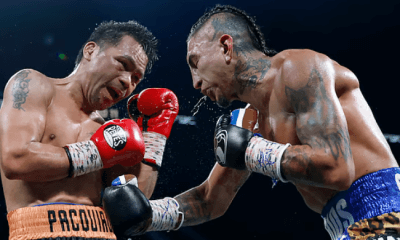
 Featured Articles4 weeks ago
Featured Articles4 weeks agoManny Pacquiao and Mario Barrios Fight to a Draw; Fundora stops Tim Tszyu
-
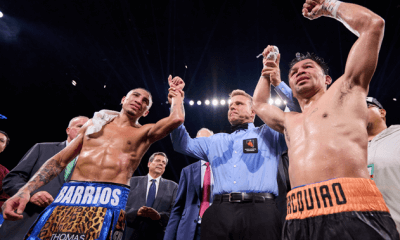
 Featured Articles4 weeks ago
Featured Articles4 weeks agoArne’s Almanac: Pacquiao-Barrios Redux
-

 Featured Articles3 weeks ago
Featured Articles3 weeks agoRemembering Dwight Muhammad Qawi (1953-2025) and his Triumphant Return to Prison
-
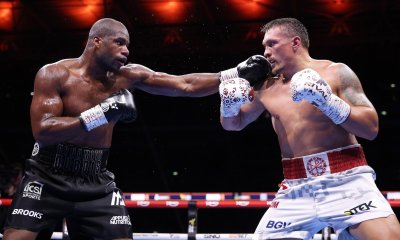
 Featured Articles4 weeks ago
Featured Articles4 weeks agoOleksandr Usyk Continues to Amaze; KOs Daniel Dubois in 5 One-Sided Rounds


